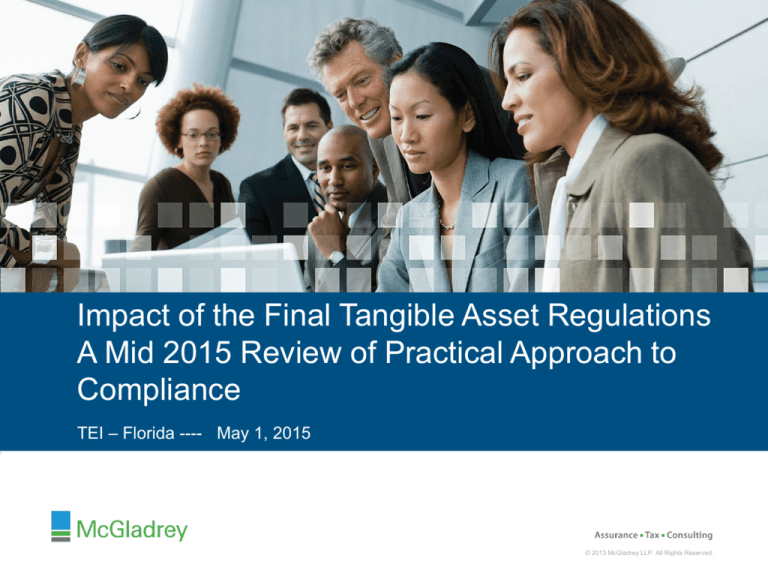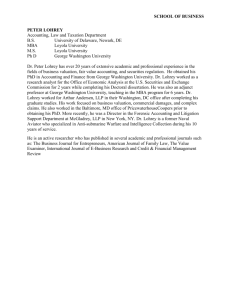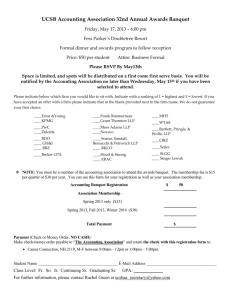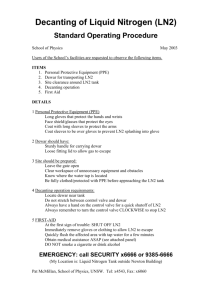
Impact of the Final Tangible Asset Regulations
A Mid 2015 Review of Practical Approach to
Compliance
TEI – Florida ---- May 1, 2015
2013 McGladrey LLP. All Rights Reserved.
© 2012
©
© 2012
2013 McGladrey
McGladreyLLP.
LLP. All
All Rights
RightsReserved.
Reserved.
Objectives --- How to attack the fundamental components of the
new regulations for compliance –
Considerations in this review:
Components of the rules and their overlap
Clear understanding of past practices
Match past practices with the components of the
new rules
Computations and disclosures for returns
Create new practices if needed
1
©
© 2012
2013 McGladrey
McGladrey LLP.
LLP. All
All Rights
Rights Reserved.
Reserved.
Current Historical Timeline
December 2011
-
Temporary and proposed regulations released
March 2012
-
Transition/method change rules issued
LB&I directive issued
November 2012
-
Notice 2012-73 issued
December 2012
-
Technical amendments issued
March 2013
-
LB&I Directive updated
Sept. 13, 2013
-
Final and proposed regulations issued
• Published in Federal Register on Sept. 19, 2013
January 2014
-
Release of first Revenue Procedure outlining new transition/method
change rules
2
©
© 2012
2013 McGladrey
McGladrey LLP.
LLP. All
All Rights
Rights Reserved.
Reserved.
General framework
Materials and supplies
Capital expenditures in general
-
De minimis safe harbors
Costs to acquire or produce tangible property
Costs to improve tangible property
Dispositions or GAAs
3
©
© 2012
2013 McGladrey
McGladrey LLP.
LLP. All
All Rights
Rights Reserved.
Reserved.
Materials and supplies—definitions
Component acquired to maintain, repair, or improve
UOP, including rotable or temporary spare parts
(rotables) and standby emergency spare parts
Fuel, lubricants, water, etc. reasonably expected to
be consumed in ≤12 months, beginning when first
used
UOP with economic useful life of ≤12 months,
beginning when first used or consumed
UOP with acquisition or production cost of ≤ $200
Identified in published guidance as materials and
supplies
4
©
© 2012
2013 McGladrey
McGladrey LLP.
LLP. All
All Rights
Rights Reserved.
Reserved.
Materials and supplies—methods
If de minimis safe harbor elected, applies to all
eligible materials and supplies except as otherwise
provided
Incidental–deduct when purchased
Non-incidental–deduct when used or consumed
Concepts around “ keeping track of and recording
balances of supplies” --- how this creates or does
not create non-incidental presumption
5
©
© 2012
2013 McGladrey
McGladrey LLP.
LLP. All
All Rights
Rights Reserved.
Reserved.
Materials and Supplies --- Spare Parts
Optional method of accounting for rotables only for
pools of rotables used in same business if also
book method
-
-
If not book method, must use for all pools of rotables in
business for tax purposes
Not eligible for de minimis safe harbor
Election to capitalize and depreciate only for
rotables or standby emergency spare parts
-
Not eligible for de minimis safe harbor
6
©
© 2012
2013 McGladrey
McGladrey LLP.
LLP. All
All Rights
Rights Reserved.
Reserved.
De minimis safe harbors
Taxpayers with Applicable Financial Statement
(AFS)
- Follow written book capitalization policy up to
$5,000 per item or invoice, as applicable, if
policy in effect and followed in AFS since
beginning of tax year
Taxpayers without AFS
- Follow book accounting procedures policy up to
$500 per item or invoice, as applicable, if book
accounting procedures in effect and followed in
books and records since beginning of tax year
Annual election
Anti-abuse rule
7
©
© 2012
2013 McGladrey
McGladrey LLP.
LLP. All
All Rights
Rights Reserved.
Reserved.
Costs to acquire or produce UOP
Capitalize amounts paid to:
-
Acquire or produce UOP
Defend or perfect title to UOP
Facilitate acquisition of UOP
• Special rules for real property investigatory costs
• Simplifying convention for employee costs and
overhead
• Contingency fees included in basis of property
acquired
- No allocation to property not acquired
Acquisition costs of property included in de minimis
safe harbor election are not capitalizable acquisition
costs
8
©
© 2012
2013 McGladrey
McGladrey LLP.
LLP. All
All Rights
Rights Reserved.
Reserved.
What in the World is a “UOP”
All the components that are functionally
interdependent comprise a single unit of property .
Components of property are functionally
interdependent if the placing in service of one
component by the taxpayer is dependent on the
placing in service of the other component by the
taxpayer. Reg §1.263(a)-3(e)(3)(i).
9
©
© 2012
2013 McGladrey
McGladrey LLP.
LLP. All
All Rights
Rights Reserved.
Reserved.
Determining the UOP
General rule—functional interdependence standard
Special rules
-
Buildings
Leased property
• Leasehold improvements made by lessee are not
treated as UOP separate from the leased property
Plant property (industrial processes)
Network assets
10
©
© 2012
2013 McGladrey
McGladrey LLP.
LLP. All
All Rights
Rights Reserved.
Reserved.
UOP within Buildings
Although a building is defined as a unit of property for other
purposes, the determination of whether an expenditure is
deducted as a repair or capitalized as an improvement is made
by treating each of nine building "systems" as a separate unit of
property. These building systems include:
1) Heating, ventilation, and air conditioning (HVAC) systems;
2) Plumbing systems;
3) Electrical systems;
4) All escalators;
5) All elevators;
6) Fire-protection and alarm systems;
7) Security systems;
8) Gas distribution systems; and
9) Other structural components that are specifically designated
as building systems in future published guidance (Reg.
§1.263(a)-3(e)(2)(ii)).
11
©
© 2012
2013 McGladrey
McGladrey LLP.
LLP. All
All Rights
Rights Reserved.
Reserved.
Routine maintenance safe harbor
Routine and recurring amounts paid to keep UOP in
ordinary efficient working condition do not improve
UOP
Application to building property (including
building systems)
-
Taxpayer reasonably expects to perform activity more
than once within 10 years of the placed-in-service
date of the building or building system
Application to non-building property
-
Taxpayer reasonably expects to perform activity more
than once during UOP’s Alternative Depreciation System
class life
12
©
© 2012
2013 McGladrey
McGladrey LLP.
LLP. All
All Rights
Rights Reserved.
Reserved.
Amounts paid to improve tangible property Reg. section 1.263(a)-3
Restoration
Betterment
Adaptation
Improvement
13
©
© 2012
2013 McGladrey
McGladreyLLP.
LLP. All
All Rights
RightsReserved.
Reserved.
Betterments
Corrects a material defect -- a material condition or
defect that either existed before the taxpayer's
acquisition of the unit of property or arose during the
production of the unit of property (whether or not the
taxpayer was aware of the condition or defect at the time
of acquisition or production);
Is for material addition or addition of major component
to UOP
Is “reasonably expected to” materially increase the
productivity, efficiency, strength, quality, or output of the
UOP
No bright-line tests
-
Additional detail in examples to clarify application of rules
14
©
© 2012
2013 McGladrey
McGladrey LLP.
LLP. All
All Rights
Rights Reserved.
Reserved.
Restorations
Replaces a component deducted as loss
Replaces a component and basis adjusted for sale or
exchange
Repair after casualty if basis adjusted
-
Revisions to casualty loss rules
Returns to operating condition if in state of nonfunctional
disrepair
Rebuilds to like-new condition after end of class life
Replaces a major component or substantial structural
part
-
Clarification of definitions of major component (function)
and substantial structural part (size)
• New definition for buildings
Addition of salvage value exception
15
©
© 2012
2013 McGladrey
McGladreyLLP.
LLP. All
All Rights
RightsReserved.
Reserved.
Adaptations
Adapts to a new or different use
Three new illustrative examples added
-
Retail drugstore adds walk-in medical clinic = adaptation
Grocery store adds sushi bar ≠ adaptation
Hospital modifies emergency room to provide both emergency
care and outpatient surgery ≠ adaptation
16
©
© 2012
2013 McGladrey
McGladrey LLP.
LLP. All
All Rights
Rights Reserved.
Reserved.
Election to capitalize repair and maintenance
costs—NEW
Annual election to capitalize repair and
maintenance costs IF:
-
Incurred in carrying on a trade or business
Treated as capital expenditures in books and records
Election applies to all repair and maintenance
amounts capitalized for book purposes
-
-
Costs treated as improvements to tangible property
• Depreciation begins when improvements placed in
service
Does not apply to repairs of rotables accounted for under
optional method
17
©
© 2012
2013 McGladrey
McGladreyLLP.
LLP. All
All Rights
RightsReserved.
Reserved.
Dispositions/GAAs
May be applied to taxable years beginning on or after
Jan. 1, 2012, and before applicability date of final
regulations
-
Certain elections may be made for years in which the timely
filed tax return has already been filed
Building (including structural components) is the asset
-
No GAA election necessary to forego disposition loss
Dispositions generally only include structural
components if make annual partial disposition election
-
Required for specified transactions (sale or section 165,
168(i)(7), 1031 or 1033 transaction)
Annual GAA election
-
Narrow definition of qualifying disposition
Special rule for IRS adjustments to repairs
18
©
© 2012
2013 McGladrey
McGladrey LLP.
LLP. All
All Rights
Rights Reserved.
Reserved.
Partial Dispositions
For purposes of the rules for dispositions of MACRS assets, a
disposition includes a disposition of a portion of an asset:
as a result of a casualty event for which gain, determined
without regard to Code Sec. 1245 and Code Sec. 1250
isn't recognized in whole or in part under Code Sec. 1031
(like-kind exchanges, or Code Sec. 1033 (involuntary
conversions,
in a transfer of a portion of an asset in a transaction described
in Code Sec. 168(i)(7)(B) (certain transactions involving
corporations or partnerships),
in a sale of a portion of an asset;
in a disposition, other than one listed above, of a portion of an
asset if the taxpayer makes an election to treat the disposition
of the disposed portion as a disposition.
19
©
© 2012
2013 McGladrey
McGladreyLLP.
LLP. All
All Rights
RightsReserved.
Reserved.
Questions?
Thank you !!
©
© 2012
2013 McGladrey
McGladrey LLP.
LLP. All
All Rights
Rights Reserved.
Reserved.
This document contains general information, may be based on authorities that are subject to change, and is not a substitute for professional advice
or services. This document does not constitute assurance, tax, consulting, business, financial, investment, legal or other professional advice, and
you should consult a qualified professional advisor before taking any action based on the information herein. McGladrey LLP, its affiliates and
related entities are not responsible for any loss resulting from or relating to reliance on this document by any person.
McGladrey LLP is an Iowa limited liability partnership and the U.S. member firm of RSM International, a global network of independent accounting,
tax and consulting firms. The member firms of RSM International collaborate to provide services to global clients, but are separate and distinct legal
entities that cannot obligate each other. Each member firm is responsible only for its own acts and omissions, and not those of any other party.
McGladrey LLP
888.811.1023
www.mcgladrey.com
McGladrey®, the McGladrey logo, the McGladrey Classic logo, The power of being understood®, Power comes from being understood®, and
Experience the power of being understood® are registered trademarks of McGladrey LLP.
© 2013 McGladrey LLP. All Rights Reserved.
©
© 2012
2013 McGladrey
McGladreyLLP.
LLP. All
All Rights
RightsReserved.
Reserved.





